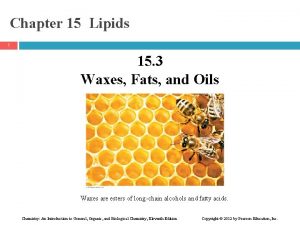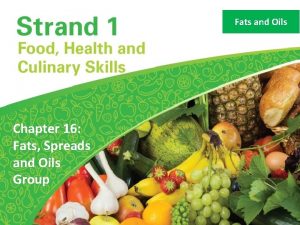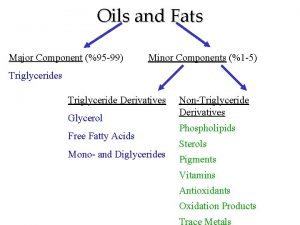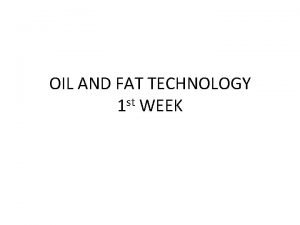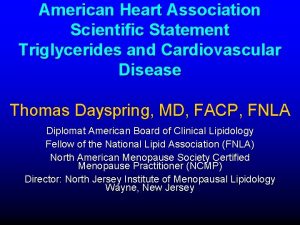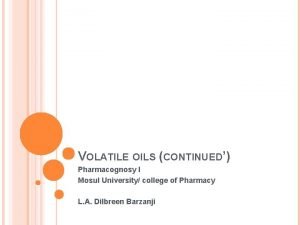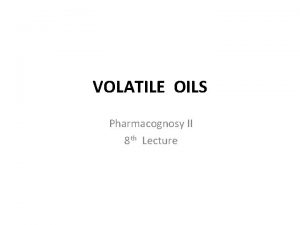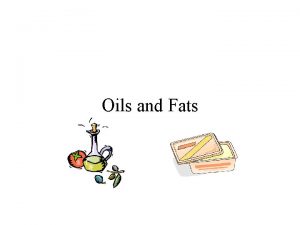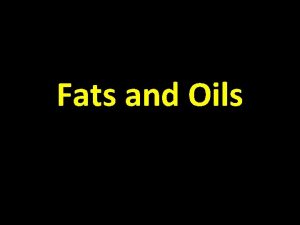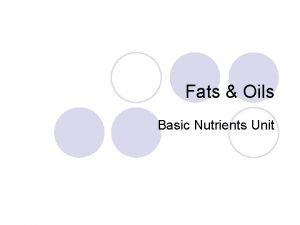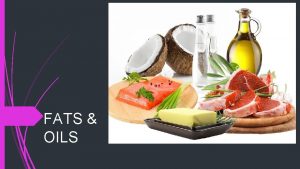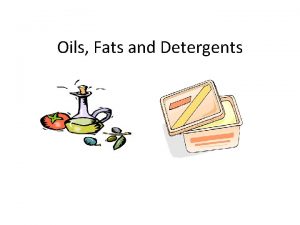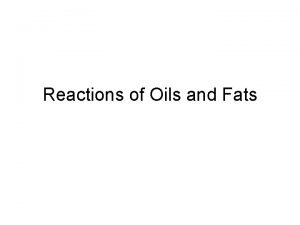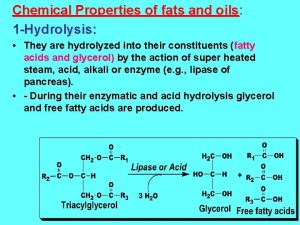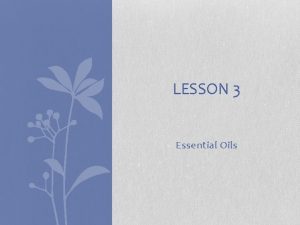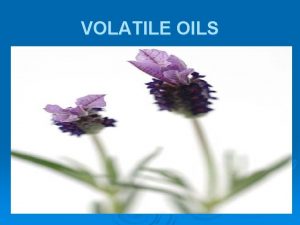Fats and Oils n Structure u u Triglyceride











- Slides: 11

Fats and Oils n Structure u u Triglyceride— 3 fatty acids attached to a glycerol backbone Various fatty acids within the TG

Fats and Oils n Types Solid fats t Straight chain fatty acids t Saturated or trans fatty acids t Fat crystals suspended in oil u Liquid fats (oils) t Contain kinked chain fatty acids t Mono- or polyunsaturated fatty acids t No fat crystals u

Fats and Oils n Melting temperature is directly proportional to degree of saturation u u saturation (less double bonds) = higher melting point saturation (more double bonds) = lower melting point

Fats and Oils n Essential fatty acids Linolenic and Linoleic acids u Excellent source of vitamin E t Combats rancidity (free radical scavenger) t Varies in amounts by: • Type of plant used for pressing • Refining process t Preserved by storing in cool, dark place t Degraded by overheating u

Fats and Oils n Influences on texture (mouth-feel) and flavor Types of fatty acids present and their corresponding chain lengths u Degree of saturation (thus melting temp. ) u Degree of refinement (flavor components removed) u

Fats and Oils n Smokepoint Involves chemical degradation of glycerol molecule u Induced by overheating u Breaks down into acrolein t Irritating to eyes and nose u

Fats and Oils n Reduction of smoke point by avoiding: u Prolonged or repeated heating of fat u Collected food particles u Exposure of fat to air t Oxidation occurs t Deep fryers are better than shallow pans u Presence of emulsifiers in fats u Use of iron and/or copper pans which contributes to oxidative rancidity

Fats and Oils n Shelf life of fat can be extended: Frying below smokepoint u Cooling quickly u n Fat absorption leads to greasy products: u Oil is not hot enough (too far below smokepoint) u Cold foods u Too much food added at once

Fats and Oils n Ingredients that increase fat absorption of food Sugar u Leavening u Aqueous liquid u Fat u n Crispiness (favorable attribute) Dehydrating outer portion of food u Exchanging fat for lost moisture u

Fats and Oils n n Fat in cheese u Butterfat u Highly saturated Types of cheese and relative fat content u Dessert cheese (comparable to butter fat) u Hard cheese (1/3 fat by weight) u Low fat cheese (about 7% fat by weight) t Fat replacers • Water • Vegetable gums

Fats and Oils n Other types u u Cheese spread (Velveeta, which uses emulsifier to aid in ease of melting) Cream cheese (soft cheese) t More water than cheddar t Fat free cream cheese utilizes:
 Is lipid long term energy
Is lipid long term energy Chapter 15
Chapter 15 Lipids definition
Lipids definition What biomolecule transports substances in and out of cells
What biomolecule transports substances in and out of cells Fats spreads and oils
Fats spreads and oils Non polar molecules that include fats oils and cholesterol
Non polar molecules that include fats oils and cholesterol H - c
H - c Iodine value formula
Iodine value formula Triglyceride levels by age
Triglyceride levels by age Volatile oil pharmaceutical uses
Volatile oil pharmaceutical uses Volatile oils - pharmacognosy
Volatile oils - pharmacognosy Brian peskin
Brian peskin

